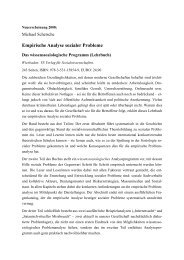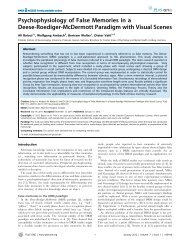Tätigkeitsbericht 2002/2003 - IGPP
Tätigkeitsbericht 2002/2003 - IGPP
Tätigkeitsbericht 2002/2003 - IGPP
Sie wollen auch ein ePaper? Erhöhen Sie die Reichweite Ihrer Titel.
YUMPU macht aus Druck-PDFs automatisch weboptimierte ePaper, die Google liebt.
Theory and Data Analysis 13<br />
einer Zunahme der Varianz der Ordnungsschwelle,<br />
wenn die Frequenzbandbreite abnimmt (und<br />
umgekehrt).<br />
Eine andere Anwendung liegt in der Herleitung<br />
eines Effektes, der in Anlehnung an den Quanten-<br />
Zeno-Effekt (siehe oben) als “Necker-Zeno-Effekt”<br />
bezeichnet wurde, da er von uns in erster Linie auf<br />
Daten aus der Wahrnehmung bistabiler Stimuli wie<br />
dem Necker-Würfel angewendet wurde. Mit Hilfe des<br />
formalen Apparates der verallgemeinerten Quantentheorie<br />
gelang es erstmals, eine quantitative Relation<br />
zwischen drei kognitiven Zeitskalen der Größenordnung<br />
von 10 1 , 10 2 , 10 3 msec abzuleiten. Diese Zeitskalen<br />
sind von unterschiedlicher kognitiver Bedeutung.<br />
Eine erste Analyse vorhandener Daten zeigt eine recht<br />
gute Übereinstimmung mit der Theorie (siehe Abb. 1).<br />
Wesentliche Charakteristika von chaotischen Systemen<br />
sind ihre Lyapunov-Exponenten. Sie quantifizieren die<br />
Stabilität der Systemdynamik gegenüber Störungen<br />
und geben an, wie weit in die Zukunft hinein sich<br />
ein System sinnvoll vorhersagen lässt. Die Bedeutung<br />
der Lyapunov-Exponenten wird dadurch unterstrichen,<br />
dass sie unabhängig davon sind, in welchem Zustandsquency<br />
bandwidth decreases, and vice versa.<br />
Inspired by the quantum Zeno effect addressed above,<br />
we predicted an effect called “Necker-Zeno effect”,<br />
since it was primarily applied to data from the perception<br />
of bistable stimuli such as the Necker cube. Using<br />
the formal tools of generalized quantum theory, we<br />
could for the first time derive a quantitative relation<br />
between three cognitive time scales of the order of<br />
10 1 , 10 2 and 10 3 msec, which are of different cognitive<br />
significance. A first analysis of available data shows<br />
good agreement with the theory (see Fig. 1).<br />
20<br />
18<br />
16<br />
14<br />
Abb. 1: Lebensdauer T (inverse Wechselraten) für die bistabile<br />
Wahrnehmung eines diskontinuierlich präsentierten Necker-<br />
Würfels als Funktion der off-Zeit t 0 . Die einzelnen Messwerte<br />
stammen aus Experimenten verschiedener Gruppen; die<br />
durchgezogene Kurve ist als Folge des Necker-Zeno Effektes theoretisch<br />
abgeleitet.<br />
Fig. 1: Lifetime T (inverse switching rates) for the bistable perception<br />
of a discontinuously presented Necker cube as a function<br />
of off-time t 0 . Individual values are experimental results obtained<br />
by different groups; the solid curve is theoretically derived<br />
as a consequence of the Necker-Zeno effect.<br />
Ein weiteres Projekt beschäftigt sich damit, inwieweit<br />
unterschiedliche Partitionierungen von Zustandsräumen<br />
kompatibel sind oder nicht. Ein erfolgversprechender<br />
theoretischer Zugang zu dieser Frage<br />
konnte identifiziert werden. Wir nehmen an, dass<br />
im wesentlichen solche Partitionen inkompatibel (also<br />
komplementär) sind, die nicht erzeugend sind. Kognitive<br />
symbolische Prozesse beruhen vermutlich auf<br />
Partitionierungen neuronaler Prozesse, von denen<br />
zunächst unwahrscheinlich ist, dass sie erzeugend sind.<br />
Dass sie demzufolge im allgemeinen inkompatibel sein<br />
werden, könnte ein Grund für die Vielfalt kognitiver<br />
bzw. psychologischer Modelle sein, die sich oft nur<br />
schwer miteinander in Verbindung bringen lassen.<br />
Atmanspacher; zusammen mit beim Graben, Filk,<br />
Römer<br />
Publikationen: Atmanspacher, Filk (<strong>2003</strong>), Atmanspacher,<br />
Filk, Römer (im Druck)<br />
T (sec)<br />
12<br />
10<br />
8<br />
6<br />
4<br />
2<br />
0<br />
0.1 0.2 0.3 0.4 0.5 0.6 0.7 0.8 0.9 1 1.1<br />
t (sec) 0<br />
In another project we study the question of whether<br />
or not different partitions of a dynamics in state space<br />
are compatible. A promising theoretical approach to<br />
address this question could be identified. We suspect<br />
that partitions (and dynamics) are essentially incompatible,<br />
i.e. complementary, if they are not generating.<br />
Cognitive symbolic processes are presumably based on<br />
partitions of neuronal processes, for which it is unlikely<br />
in the first place that they are generating. As a consequence<br />
they can be generally assumed to be incompatible.<br />
This may be a reason for the rich variety of<br />
cognitive or psychological models, respectively, which<br />
are often not easily related to each other.<br />
Atmanspacher; together with beim Graben, Filk,<br />
Römer<br />
Publications: Atmanspacher, Filk (<strong>2003</strong>), Atmanspacher,<br />
Filk, Römer (in press)<br />
Beobachterabhängigkeit von Chaos<br />
Observer-Dependence of Chaos<br />
Essential characteristics of chaotic systems are their<br />
Lyapunov exponents. They quantify the stability of<br />
the system against perturbations and indicate how far<br />
into the future its behavior can be reasonably predicted.<br />
The significance of the Lyapunov exponents is<br />
emphasized by their independence of the state space in<br />
which the system is represented: Lyapunov exponents


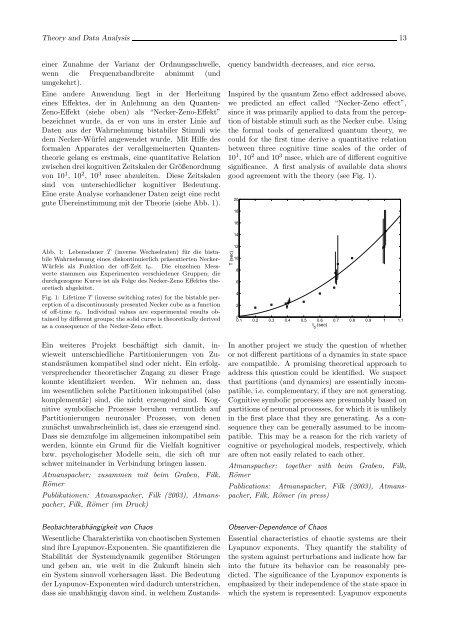
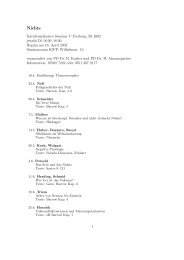
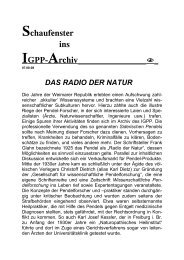
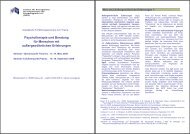
![Findliste Nachträge1 [pdf] - IGPP](https://img.yumpu.com/22552359/1/184x260/findliste-nachtrage1-pdf-igpp.jpg?quality=85)

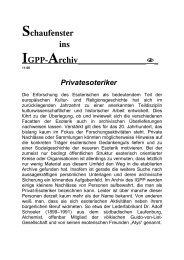
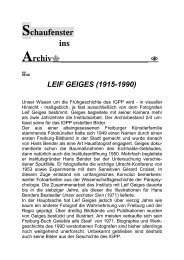
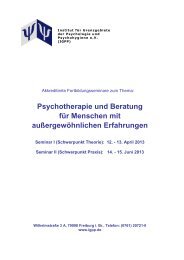
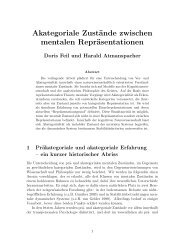
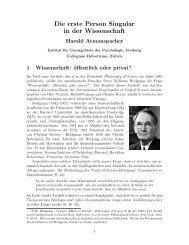
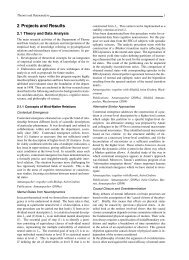
![Findliste [pdf] - IGPP](https://img.yumpu.com/22552265/1/190x245/findliste-pdf-igpp.jpg?quality=85)

